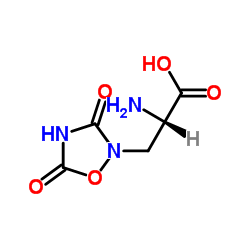Quisqualic acid

Quisqualic acid structure
|
Common Name | Quisqualic acid | ||
|---|---|---|---|---|
| CAS Number | 52809-07-1 | Molecular Weight | 189.126 | |
| Density | 2.0±0.1 g/cm3 | Boiling Point | 405.9±55.0 °C at 760 mmHg | |
| Molecular Formula | C5H7N3O5 | Melting Point | 185-187ºC dec. | |
| MSDS | Chinese USA | Flash Point | 199.3±31.5 °C | |
| Symbol |

GHS07 |
Signal Word | Warning | |
|
Chemical genetics reveals a complex functional ground state of neural stem cells.
Nat. Chem. Biol. 3(5) , 268-273, (2007) The identification of self-renewing and multipotent neural stem cells (NSCs) in the mammalian brain holds promise for the treatment of neurological diseases and has yielded new insight into brain cancer. However, the complete repertoire of signaling pathways ... |
|
|
Long-term administration of the antidepressant vilazodone modulates rat brain monoaminergic systems.
Neuropharmacology 99 , 696-704, (2015) Vilazodone has high affinity for the human 5-hydroxytryptamine1A (h5-HT1A) receptor and for the serotonin transporter (5-HTT). A previous in vivo microdialysis experiment showed that a single administration of vilazodone, dose-dependently increases extracellu... |
|
|
Conformationally-restricted amino acid analogues bearing a distal sulfonic acid show selective inhibition of system [formula omitted]over the vesicular glutamate transporter
Bioorg. Med. Chem. Lett. 20 , 2680-3, (2010) A panel of amino acid analogs and conformationally-restricted amino acids bearing a sulfonic acid were synthesized and tested for their ability to preferentially inhibit the obligate cysteine-glutamate transporter system x(c)(-) versus the vesicular glutamate... |
|
|
Anxiolytic properties of Valeriana officinalis in the zebrafish: a possible role for metabotropic glutamate receptors.
Planta Med. 78(16) , 1719-24, (2012) Valerian extract is used in complementary and alternative medicine for its anxiolytic and sedative properties. Our previous research demonstrated valerian interactions with glutamate receptors. The purpose of this study was to determine if valerian anxiolytic... |
|
|
Effects of acute and sustained administration of vortioxetine on the serotonin system in the hippocampus: electrophysiological studies in the rat brain.
Psychopharmacology 232 , 2343-52, (2015) Vortioxetine is a novel multimodal antidepressant that is a 5-HT1B receptor partial agonist, a 5-HT1A receptor agonist, an inhibitor of the serotonin (5-HT) transporter, and a 5-HT1D, 5-HT3, and 5-HT7 receptor antagonist in vitro. In vivo studies have shown t... |
|
|
Chemo-enzymatic synthesis of a series of 2,4-syn-functionalized (S)-glutamate analogues: new insight into the structure-activity relation of ionotropic glutamate receptor subtypes 5, 6, and 7.
J. Med. Chem. 51 , 4093-103, (2008) ( S)-Glutamic acid (Glu) is the major excitatory neurotransmitter in the central nervous system (CNS) activating the plethora of ionotropic Glu receptors (iGluRs) and metabotropic Glu receptors (mGluRs). In this paper, we present a chemo-enzymatic strategy fo... |
|
|
Structural insight into the pharmacophore pocket of human glutamate carboxypeptidase II.
J. Med. Chem. 50 , 3267-73, (2007) Inhibition of glutamate carboxypeptidase II (GCPII) has been shown to be neuroprotective in multiple preclinical models in which dysregulated glutamatergic transmission is implicated. Herein, we report crystal structures of the human GCPII complexed with thre... |
|
|
Structural insight into the evolutionary and pharmacologic homology of glutamate carboxypeptidases II and III.
FEBS J. 276(16) , 4448-62, (2009) Glutamate carboxypeptidase III (GCPIII) is a metalloenzyme that belongs to the transferrin receptor/glutamate carboxypeptidase II (GCPII; EC 3.4.17.21) superfamily. GCPIII has been studied mainly because of its evolutionary relationship to GCPII, an enzyme in... |
|
|
Selective and sustained α-amino-3-hydroxy-5-methyl-4-isoxazolepropionic acid receptor activation in cerebellum induces dystonia in mice.
J. Pharmacol. Exp. Ther. 340(3) , 733-41, (2012) Dystonia is a neurological disorder characterized by involuntary muscle contractions that cause twisting movements and abnormal postures. Functional imaging consistently reveals cerebellar overactivity in dystonic patients regardless of the type or etiology o... |
|
|
Evaluation of cannabinoid receptor 2 and metabotropic glutamate receptor 1 functional responses using a cell impedance-based technology.
J. Biomol. Screen. 15(10) , 1238-47, (2010) Recently, new technologies based on biosensors and called label free have been developed. These technologies eliminate the need for using markers and dyes. The authors applied one of these technologies, based on measurement of cell impedance variation, to stu... |